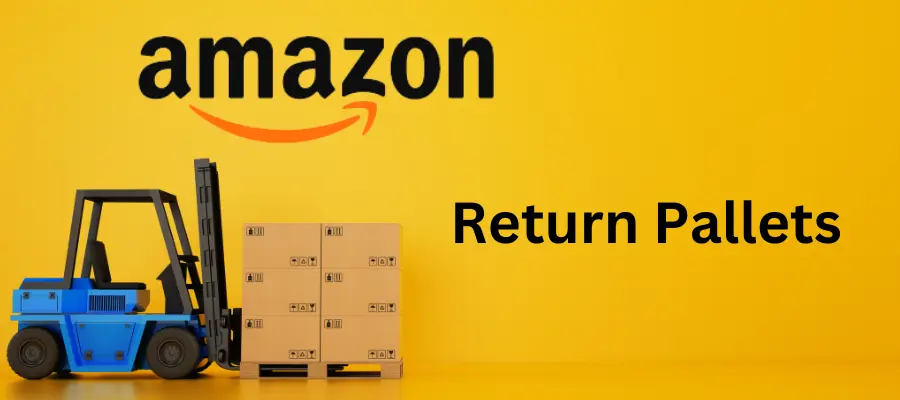Turning a profit by purchasing and selling Amazon Return Pallets presents a significant opportunity for sellers, whether they are major players or small-scale participants in the market. This method allows them to tap into the substantial number of returned products resulting from Amazon's generous 30-day return policy.
Amazon's customer-friendly return policy, allowing product returns within a 30-day window with no questions asked, ensures customer satisfaction but also contributes to a notable return rate on the platform, on average 10% return rate. Typically, these returned items are sent back to the seller, incurring a fee. However, Amazon sellers may find it economically impractical to retrieve these products from Amazon's warehouse.
The challenge lies in efficiently buying and selling these Amazon return pallets to maximize profitability. This involves understanding what Amazon returns pallet is and implementing a strategic approach to buy Amazon pallets return and capitalize on the market potential.
The challenge lies in efficiently buying and selling these Amazon return pallets to maximize profitability. This involves understanding what Amazon returns pallet is and implementing a strategic approach to buy Amazon pallets return and capitalize on the market potential.
Understanding Amazon Return Pallets
Amazon liquidation pallets, also known as Amazon Return Pallets, are substantial wooden crates utilized by Amazon to wholesale returned products. These pallets can encompass a variety of items, ranging from electronics, clothes, books, furniture, and more. The condition of these products varies, including being used, damaged, defective, or simply unwanted by the original customer.
Large liquidation companies or individual customers can purchase these pallets directly from Amazon at discounted prices. The buyers then have the option to retain useful products for personal use, refurbish others for resale, and thus, potentially make a profit.
The profitability of buying Amazon Return Pallets is apparent, although the contents of the pallets are not guaranteed. Inside, one might discover brand new items, broken products, spare parts, or even empty boxes. Despite the uncertainties, thorough research can help mitigate risks and increase the chances of turning a profit.
Cost of Amazon Return Pallets
To gauge the investment in Amazon Return Pallets, it's crucial to delve into the associated costs. These pallets come with a price tag ranging from $300 to $500, influenced by factors like size and contents. For instance, a sizable pallet stocked with electronics may surpass the $900.
However, the analysis doesn't end with the pallet cost alone. Additional factors, such as shipping fees and potential refurbishment expenses, should be factored into the overall expenditure.
Smart Strategies for Successful Amazon Return Pallet Purchases
Purchasing Amazon Return Pallets can be a lucrative endeavor, but it requires savvy decision-making to ensure success. To guide your buying process, consider the following factors:
- Start Small: Before committing to significant investments, initiate with a small purchase. This approach allows you to familiarize yourself with the buying experience and comprehend the overall process. Avoid the allure of immediately splurging on expensive name-brand items to minimize risks.
- Evaluate Sellers: Thoroughly vet sellers by examining their industry experience and professional company information pages. Utilize resources like the Better Business Bureau for additional insights into your chosen seller.
- Manifested vs. Mystery Pallets: Choose between manifested and mystery pallets based on your strategy. While mystery pallets are cheaper, they carry higher risk. Manifested pallets, though more expensive, provide detailed content descriptions, aiding in informed resale decisions.
- Compare Alternative Platforms: Given the multitude of liquidation companies, research and compare various options. Seek companies that offer return pallets at lower costs to maximize potential profit margins.
- Caution with Electronics: If you're new to purchasing Amazon liquidation pallets, steer clear of buying pallets containing used electronic items. The risk of non-functional items is high, and without the expertise to repair them, it could lead to substantial losses.
- Avoid Risky Categories: Mitigate risks by avoiding certain product categories. For instance, steer clear of baby items due to safety concerns, and bypass cooking products, which may be challenging to resell. Similarly, avoid items with multiple parts to minimize the chances of missing or damaged components.
- Simplicity Sells: Opt for simpler items that have a higher probability of working properly and are easy to resell. Items like exercise dumbbells fit this criterion. While name-brand goods are desirable, ensure the likelihood of defects is low, particularly when it comes to electronics.
- Shipping Cost Awareness: Before finalizing your purchase, be mindful of shipping expenses. Some liquidation companies impose shipping charges that might surpass the amount paid for the goods. Always check freight costs in advance to avoid unexpected surprises.
By considering these factors and approaching your Amazon Return Pallet purchases with caution, you can increase your chances of a successful and profitable venture in the resale market.
Where to buy Amazon Return Pallets
Exploring avenues for purchasing Amazon Return Pallets involves various options. One method is through Amazon's liquidation program, enabling sellers to auction customer-returned products and make room for new inventory in the warehouse. These auctions typically occur post-holiday sales, coinciding with increased customer returns.
Alternatively, you can directly buy Amazon Return Pallets through this program or opt for third-party liquidation companies. For those seeking options in 2024, several reputable companies for US and Canada are as follows:
- Amazon Liquidation Auctions (US)
- Liquidation.com (US)
- Direct Liquidation (US and Canada)
- 888Lots
- BULQ (US)
- BlueLots
- Quicklotz (US)
- Via Trading (US)
These companies provide avenues to procure Amazon Return Pallets and delve into the world of liquidation for potential business opportunities.
Advises to Sell Products from Amazon Return Pallets
Here are key insights to keep in mind for selling Amazon Return Pallets in 2024:
- Strategic Pricing: Research various online markets to understand the current prices. Set your selling price below that of new items, factoring in other expenses while keeping a close eye on potential profits. Leverage the substantial discounts received when purchasing Amazon return pallets to your advantage. Aggressively price your products to outperform competitors on Amazon.
- Calculate Shipping Costs: Ensure that shipping costs are factored into your calculations, as they can impact your potential profits significantly.
- Diversify Sales Platforms: After thorough analysis of the pallet, recognize that not all products may be profitable on FBA or FBM. Explore alternative platforms like Facebook Marketplace, Craigslist, or eBay for one-off products.
- Strategic Sorting and Categorization: Upon receiving the pallet, meticulously inspect and categorize the products. Evaluate packaging and product condition, ensuring authenticity and the presence of a manufacturer's warranty. Address missing or faulty parts to enhance resale value.
- Professional Repackaging: When repackaging items, consider designing your own packaging for various sizes. This allows for easy removal from the original package and placement into new boxes.
- Effective Product Bundling: Refurbishing and repairing are crucial, but bundling complementary products can increase the average order value. For instance, assembling a CPU with a mix of new and refurbished products from a pallet of computer components can be sold at a premium.
Conclusion
Delving into the realm of Amazon Return Pallets offers a promising avenue for both major players and small-scale sellers in the market. The lucrative opportunity to turn a profit by capitalizing on returned products, courtesy of Amazon's customer-friendly return policy, presents a viable strategy.
Efficiently navigating the purchase and sale of Amazon Return Pallets is the key challenge, demanding a strategic approach to maximize profitability. Understanding the nature of these pallets and implementing smart purchasing strategies can significantly impact success in the dynamic e-commerce landscape.
In essence, by embracing caution, conducting thorough research, and implementing strategic approaches, sellers can unlock the potential of Amazon Return Pallets for a profitable venture in the e-commerce marketplaces.


